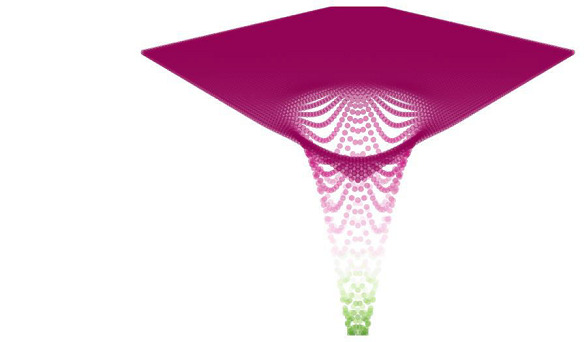基於教學學習最佳化的實現
簡介
基於教學學習最佳化 (TLBO) 演算法基於課堂上教師與學習者之間的關係。在一個特定的課堂中,教師透過其辛勤工作向學生傳授知識。然後,學生或學習者彼此互動並提高他們的知識。
讓我們透過本文進一步瞭解基於教學學習的最佳化。
什麼是 TLBO?
讓我們考慮一個群體 p(特別是課堂)和課堂中學習者的數量 l。對於最佳化問題,可能存在決定性變數(學習者從中獲取知識的科目)。可以發生兩種學習模式:
透過教師(教學階段)
透過學習者之間相互互動(學習階段)
我們關注學習者的結果,這將是適應度值。
TLBO 最佳化函式
最佳化演算法涉及兩種型別的函式。它們是
球面函式 - 用於評估效能
其數學表示式為:
$$\mathrm{f(x_{1,}x_{2},.........x_{n})=\sum ^{n}_{i=0} \:\:x^{2}_{i}}$$
在 f(0,..0) = 0 處取得最小值
Rastrigin 函式 - 用作測試函式的非凸函式,其數學表示式為:
$$\mathrm{f(x_{1,}x_{2},.........x_{n})=10+}\mathrm{\sum_{i=1}^{n} (x^{2}_{i}-10\cos\:\:\cos(2\prod x_{i})}$$
在 Python 中實現 TLBO 演算法
示例
import numpy as np
from pyMetaheuristic.algorithm import teaching_learning_based_optimization
from pyMetaheuristic.utils import graphs
def eas_opt(varval = [0, 0]):
x_1, x_2 = varval
fval = -np.cos(x_1) * np.cos(x_2) * np.exp(-(x_1 - np.pi) ** 2 - (x_2 - np.pi) ** 2)
return fval
plt_params = {
'min_values': (-6, -6),
'max_values': (6, 6),
'step': (0.2, 0.2),
'solution': [],
'proj_view': '3D',
'view': 'notebook'
}
graphs.plot_single_function(target_function = eas_opt, **plt_params)
params = {
'population_size': 15,
'min_values': (-5, -5),
'max_values': (5, 5),
'generations': 500,
'verbose': True
}
tlbo = teaching_learning_based_optimization(target_function = eas_opt, **params)
vars = tlbo[:-1]
min = tlbo[ -1]
print('Variables: ', np.around(vars, 5) , ' Minimum Value Found: ', round(min, 5) )
plt_params = {
'min_values': (-6, -6),
'max_values': (6, 6),
'step': (0.2, 0.2),
'solution': [vars],
'proj_view': '3D',
'view': 'notebook'
}
graphs.plot_single_function(target_function = eas_opt, **plt_params)
輸出

Generation = 0 f(x) = -0.5748727344288006 Generation = 1 f(x) = -0.7555913129284719 Generation = 2 f(x) = -0.9219320357862593 Generation = 3 f(x) = -0.9644524112155972 Generation = 4 f(x) = -0.9809361915349301 Generation = 5 f(x) = -0.991863434885587 Generation = 6 f(x) = -0.9984949247685845 Generation = 7 f(x) = -0.9991563851570532 Generation = 8 f(x) = -0.9997584334443873 Generation = 9 f(x) = -0.9997584334443873 Generation = 10 f(x) = -0.9998450580252695 Generation = 11 f(x) = -0.9998982502404465 Generation = 12 f(x) = -0.999961847330126 Generation = 13 f(x) = -0.9999810734164969 Generation = 14 f(x) = -0.9999930426674921 Generation = 15 f(x) = -0.9999995055655798 Generation = 16 f(x) = -0.9999999410594664 Generation = 17 f(x) = -0.9999999410594664 Generation = 18 f(x) = -0.9999999877205884 Generation = 19 f(x) = -0.9999999877205884 Generation = 20 f(x) = -0.9999999931826284 ------------------------------------------------------------- ------------------------------------------------------- Generation = 500 f(x) = -0.9999999991966855 Variables: [3.14161 3.14158] Minimum Value Found: -1.0
基於教學學習最佳化的優勢
TLBO 演算法除了群體大小和迭代次數這兩個引數外,不需要任何其他引數即可執行。
它更準確,並且不需要導數。
遵循完整的路徑生成解決方案
基於教學學習最佳化的缺點
這是一個耗時的演算法
最佳化演算法執行需要大量的空間
結論
基於教學學習最佳化是一種基於群體的演算法,它嚴重依賴於教師與學習者之間以及學習者之間的學習關係。

廣告

 資料結構
資料結構 網路
網路 關係型資料庫管理系統 (RDBMS)
關係型資料庫管理系統 (RDBMS) 作業系統
作業系統 Java
Java iOS
iOS HTML
HTML CSS
CSS Android
Android Python
Python C 程式設計
C 程式設計 C++
C++ C#
C# MongoDB
MongoDB MySQL
MySQL Javascript
Javascript PHP
PHP